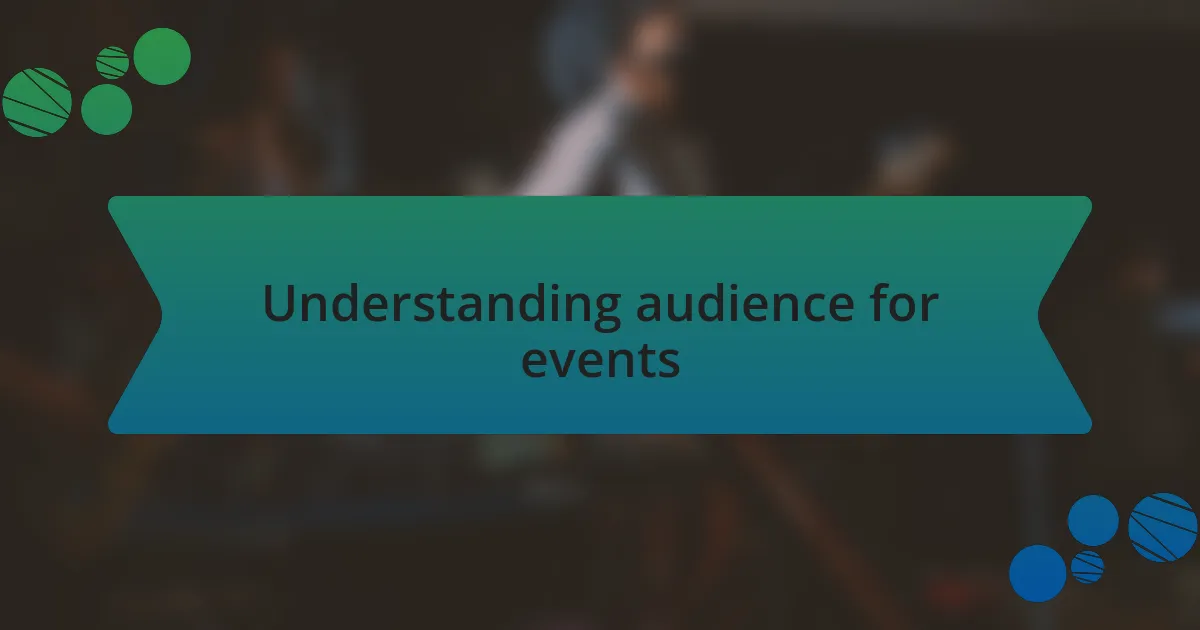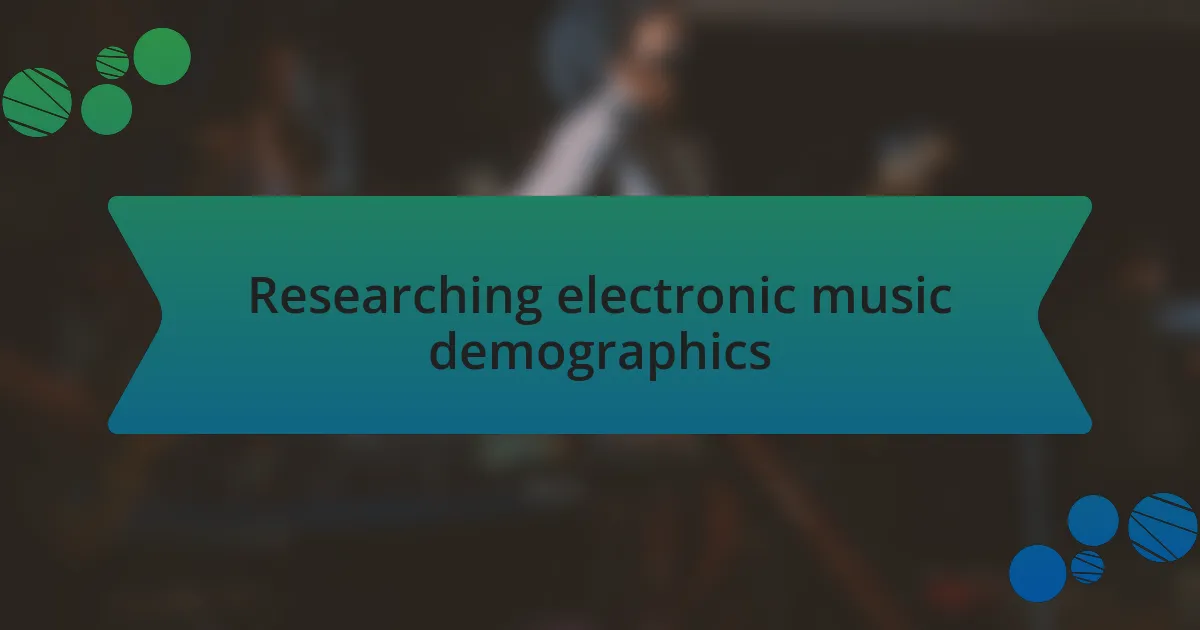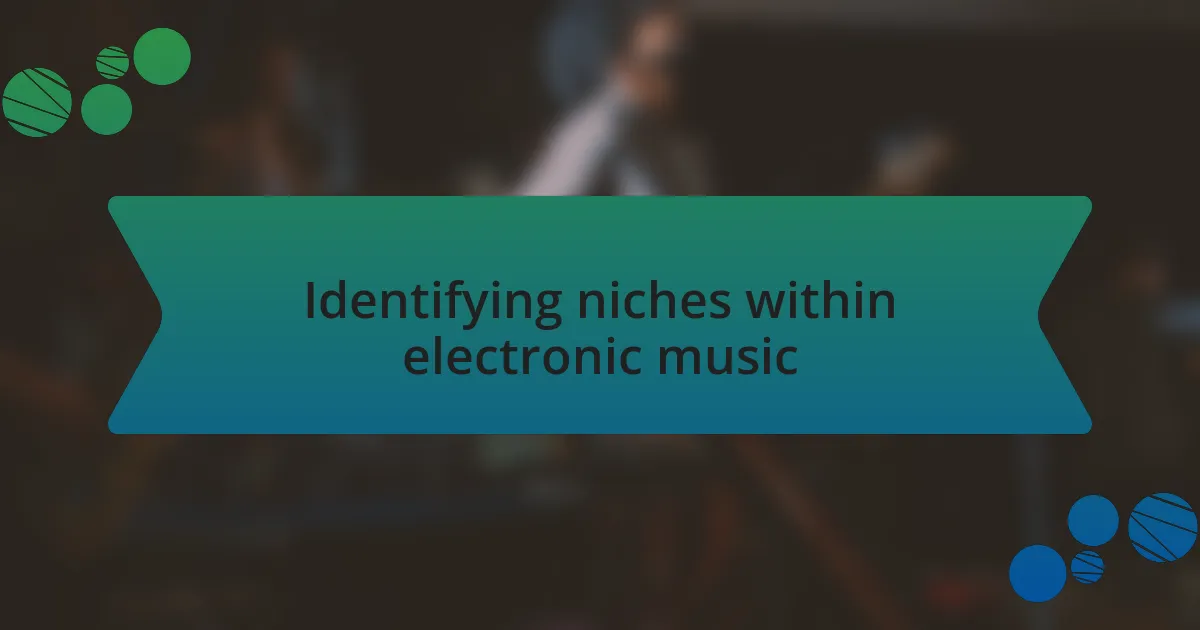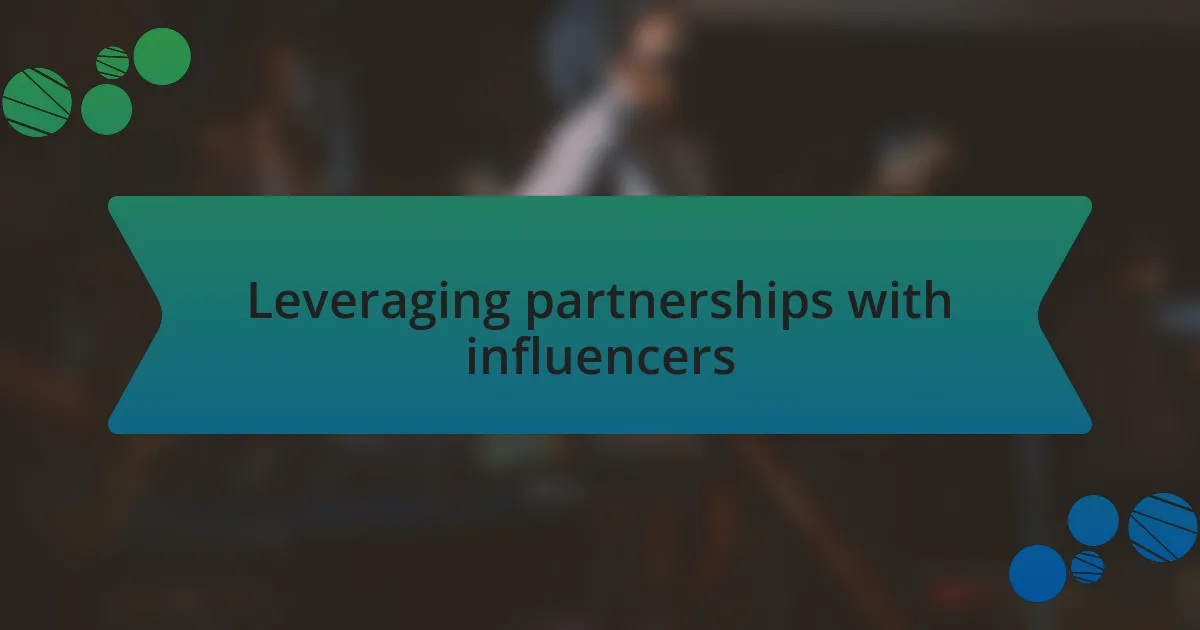Key takeaways:
- Understanding audience preferences and emotional drivers enhances event experiences and satisfaction.
- Researching demographics and engaging with online communities informs tailored event planning and programming.
- Leveraging partnerships with influencers can amplify event reach and create a sense of community.
- Measuring success involves analyzing feedback and adjusting based on audience insights for improved future experiences.

Understanding audience for events
Understanding your audience for events is crucial, particularly in the electronic music scene. I remember when I first organized an event; I focused solely on the lineup, thinking that would attract attendees. It wasn’t until I engaged with the potential audience through social media polls that I realized they craved interactive experiences and immersive environments just as much as the music itself.
When I analyze the crowd at a particular event, I look for specific characteristics—age, tastes, and even social behaviors. A unique experience can often hinge on knowing whether your audience prefers intimate gatherings or large festivals. Reflecting on a past event, I tailored the venue setup based on feedback, and it was astonishing how much a simple adjustment influenced attendee satisfaction.
Have you considered how your events resonate emotionally with your target audience? I once hosted a small electronic night that unexpectedly attracted a diverse crowd. The shared energy and connection between the attendees created a memorable experience, demonstrating that understanding the emotional drivers of your audience can lead to unforgettable events.

Researching electronic music demographics
Researching electronic music demographics is like peeling back the layers of a complex onion; each layer reveals something new and valuable about your audience. I often turn to analytics tools to gather insights on age groups and listening habits, which has proven essential for informing my event planning. For instance, discovering that a significant portion of my followers falls within the 18-24 age range urged me to create a vibrant, high-energy atmosphere tailored to their preferences.
Another aspect I’ve found vital is engaging with online communities dedicated to electronic music. By immersing myself in forums and social media groups, I can observe discussions and trends that reveal what resonates with different demographics. I recall a time when I attended an online discussion about music styles, and it highlighted the rising popularity of techno among younger fans, which inspired me to incorporate more techno acts into future lineups.
Have you ever considered how cultural influences shape music preferences? In my experience, exploring the origins of different sub-genres of electronic music has opened doors for deeper connections with my audience. For instance, when I planned a tribute event celebrating the roots of house music, I found that attendees who were familiar with its history brought an authentic energy that profoundly enhanced the overall vibe.

Identifying niches within electronic music
When identifying niches within electronic music, I often think about the sheer variety of styles and how they resonate with distinct groups. For example, while underground acid house has a dedicated following, the accessibility of future bass attracts a younger, more mainstream crowd. This divergence prompts me to tailor my event promotions carefully to capture the essence of each genre, ensuring I connect meaningfully with the right audience.
I recall a recent experience where I experimented with booking artists from various sub-genres for a single event. Surprisingly, it became evident that each act attracted a unique subset of attendees, illustrating how niche preferences shape event dynamics. This layering of genres created a rich tapestry of musical experience, fostering conversations among fans of different styles. Have you ever witnessed how a specific sound can draw an unexpected crowd? Seeing their excitement reminded me of how crucial it is to dive deep into niche communities.
While exploring these niches, I’ve learned that attending smaller events can provide invaluable insights. I once visited a minimal techno gathering that felt almost like a secret society. The energy in the room was electric, underscoring the intense loyalty these niche audiences often have toward their preferred sub-culture. Engaging in smaller scenes allows me to better understand their rhythm and build connections that are often absent in larger, more commercial settings.

Leveraging partnerships with influencers
When it comes to leveraging partnerships with influencers, I often think about the power of genuine connections. I remember collaborating with an up-and-coming DJ who had a strong presence on social media. We organized a Q&A session together, and the engagement was phenomenal. It made me realize that when influencers authentically promote an event, it creates a buzz that transcends mere advertisement—it’s like getting a personal recommendation from a friend.
I’ve also seen the impact of micro-influencers in the electronic music scene. Once, I teamed up with a local blogger who passionately covers underground events. Her followers trust her insights, and when she shared our event, I noticed an immediate uptick in ticket sales. This highlighted for me how aligning with influencers who have an authentic connection to their audience can amplify my message and attract the right crowd.
Such partnerships not only broaden reach but also foster a sense of community. I’ve found that when influencers share their personal experiences about the event, it resonates deeply with their followers. Have you ever noticed how a story can evoke a feeling, making you want to be part of something? This emotional connection can transform a simple promotional post into a rallying cry for fans to come together and celebrate the music they love.

Measuring success and making adjustments
Evaluating the success of an event isn’t just about numbers; it’s about understanding what those numbers indicate. After a recent festival, I poured over ticket sales, social media engagement, and attendee feedback. It was enlightening to see how a slight dip in online engagement directly correlated with certain promotional techniques we used. I wondered, could we have activated more excitement by targeting different platforms or using varied messaging?
Adjustments come naturally when you really listen to your audience. I recall receiving feedback about the sound quality at one of our events. While challenging to hear at first, I acted on it, reaching out to the attendees who reported issues. This open dialogue helped me tweak our sound setup for future events, resulting in a noticeably improved atmosphere. Isn’t it fascinating how small changes can lead to a more immersive experience and higher satisfaction?
Tracking metrics like attendance or social media buzz helps, but personal connection is the real indicator of success. At one show, I noticed that the energy in the crowd shifted dramatically when I made a personal shoutout to some local musicians. The room exploded with enthusiasm, and I realized that these moments of recognition create lasting impressions. How can we continue to cultivate that sense of community and excitement at future events? Building on these insights is key to attracting the right audience and creating memorable experiences.